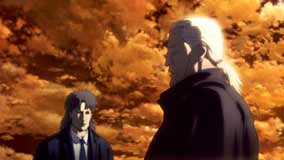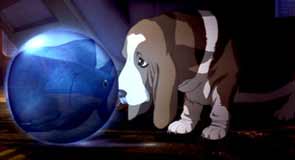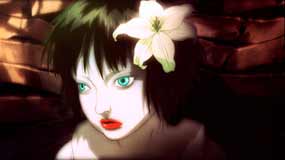Ghost in the Shell 2: Innocence (Mamoru Oshii, 2004)
 Thereís a thin line between visuals
that merely look ďreally coolĒ and those that can truly be described as
visionary, and thereís little denying that the distinction between one and the
other is mostly a personal judgment call. Still, I think it can be said that at
least one series of animated marvels in Mamoru Oshiiís Ghost in the Shell
2: Innocence qualifies. About two-thirds of the way into the film, the
narrative grinds to a halt so that we can watch an utterly dazzling sequence
that showcases a futuristic parade filled with costumed dancers and gargantuan
floats. The visuals suddenly donít need the justification that the plot had
been providing, and the effect of viewing such wonders for their own sake is
exhilarating. Unfortunately, the spectacle doesnít last nearly long enough.
Oshii even stops midway through the cycle to flash back to his heroes as they
extract some info from a thug. As a result, the sequence only temporarily provides
reprieve from a story that is cast in the familiar mold of Blade Runner and
I, Robot. Itís regrettable, but perhaps a bit predictable, that a film
that is this forward-looking in its graphic construction is saddled with a
commonplace plotline.
Thereís a thin line between visuals
that merely look ďreally coolĒ and those that can truly be described as
visionary, and thereís little denying that the distinction between one and the
other is mostly a personal judgment call. Still, I think it can be said that at
least one series of animated marvels in Mamoru Oshiiís Ghost in the Shell
2: Innocence qualifies. About two-thirds of the way into the film, the
narrative grinds to a halt so that we can watch an utterly dazzling sequence
that showcases a futuristic parade filled with costumed dancers and gargantuan
floats. The visuals suddenly donít need the justification that the plot had
been providing, and the effect of viewing such wonders for their own sake is
exhilarating. Unfortunately, the spectacle doesnít last nearly long enough.
Oshii even stops midway through the cycle to flash back to his heroes as they
extract some info from a thug. As a result, the sequence only temporarily provides
reprieve from a story that is cast in the familiar mold of Blade Runner and
I, Robot. Itís regrettable, but perhaps a bit predictable, that a film
that is this forward-looking in its graphic construction is saddled with a
commonplace plotline.
 Beginning with a series of murders, in
which androids created to give sexual pleasure have begun to
assassinate their owners, this police procedural imagines investigative
techniques for a world whose time has not yet come. The animation has amazing
depth of field, ever-pulsing lights, and insanely busy backgrounds, all achieved
through a nearly seamless integration of CGI effects. It must be pointed out,
though, that the characters,
tellingly, are 2-D figures in a 3-D world, and by far the least detailed things
on display. Though the two main characters, the police officers in charge of the
investigation, are relatively well fleshed-out, the supporting cast exists
mostly to add to the body count. Thereís a depressed mood that permeates
throughout the movie, and no character can ever be said to enliven it. Though the world that the movie takes
place in isnít as bleak as Blade
Runnerís, this is an even more humorless film overall. Even ready-made
opportunities for fun scenes are squandered. Disappointingly, we never see the
sex dolls performing the functions theyíve been designed to do and the refusal
to incorporate that kind of adult material creates a context where the gory
action sequences feel a bit obligatory and punishing. Worse still, despite the
fact thatthe film is about the hunt for a murderer, the plot is constructed in a way that
essentially mutes all suspense. There are no chase scenes and only a few moments
feature action of note. Fortunately, itís not a total loss. One inspired
sequence, in which one of the main characters suffers from a brainhacking
results in a distinctly Proustian nightmare, in which the man enters his distorted
memories, only to meet his death repeatedly and face his nightmarish mechanical
doppelganger. Another highlight is the sequence in which the infiltration of a
facility is partially conveyed to the audience as a swirl of progressively
changing computer code.
Beginning with a series of murders, in
which androids created to give sexual pleasure have begun to
assassinate their owners, this police procedural imagines investigative
techniques for a world whose time has not yet come. The animation has amazing
depth of field, ever-pulsing lights, and insanely busy backgrounds, all achieved
through a nearly seamless integration of CGI effects. It must be pointed out,
though, that the characters,
tellingly, are 2-D figures in a 3-D world, and by far the least detailed things
on display. Though the two main characters, the police officers in charge of the
investigation, are relatively well fleshed-out, the supporting cast exists
mostly to add to the body count. Thereís a depressed mood that permeates
throughout the movie, and no character can ever be said to enliven it. Though the world that the movie takes
place in isnít as bleak as Blade
Runnerís, this is an even more humorless film overall. Even ready-made
opportunities for fun scenes are squandered. Disappointingly, we never see the
sex dolls performing the functions theyíve been designed to do and the refusal
to incorporate that kind of adult material creates a context where the gory
action sequences feel a bit obligatory and punishing. Worse still, despite the
fact thatthe film is about the hunt for a murderer, the plot is constructed in a way that
essentially mutes all suspense. There are no chase scenes and only a few moments
feature action of note. Fortunately, itís not a total loss. One inspired
sequence, in which one of the main characters suffers from a brainhacking
results in a distinctly Proustian nightmare, in which the man enters his distorted
memories, only to meet his death repeatedly and face his nightmarish mechanical
doppelganger. Another highlight is the sequence in which the infiltration of a
facility is partially conveyed to the audience as a swirl of progressively
changing computer code.
 Moments like this in Innocence
are too rare, in the same way that brilliant moments are too rare in any
underachieving film, but they will help to make the movie bearable for those who
arenít fans of anime. The philosophical concerns that many find intolerable in
most Japanese animations are here in full force (Descartes is referenced at one
point), and the majority of scenes are only vaguely enlightening disquisitions
about the nature of the rapidly advancing robots. The pursuit of artificial
intelligence brings this futuristic society closer to an understanding of human
nature, and ironically enough, they mostly find more and more how robotic our
responses are. The very tenets of humanity are being challenged and explained
with scientific theorems, resulting in a world set on edge. Anomalies are
everywhere. Robots keep pet robots of their own, another robot has a pet dog
despite the fact that it interferes with his job, one human sees his choice to
become fully robotic as an evolutionary step, and a hell of a lot of normal
people who are intimidated by all of it. On an extratextual level, Innocenceís
existential concerns about the artificial replacing life as we know it seem
to be inherently tied in with the rapid advances being made in the animation
field. After all, with the advent of CGI, itís getting impossible to tell
animation from filmed reality. The deliberate choice to use 2-D character art in
a film this close to the state of the art and the relative blandness of most of
the human characters in this swirling fantasia of technology, however, suggests
that the thought of artificial actors that could replace the real thing is still
true sci-fi.
Moments like this in Innocence
are too rare, in the same way that brilliant moments are too rare in any
underachieving film, but they will help to make the movie bearable for those who
arenít fans of anime. The philosophical concerns that many find intolerable in
most Japanese animations are here in full force (Descartes is referenced at one
point), and the majority of scenes are only vaguely enlightening disquisitions
about the nature of the rapidly advancing robots. The pursuit of artificial
intelligence brings this futuristic society closer to an understanding of human
nature, and ironically enough, they mostly find more and more how robotic our
responses are. The very tenets of humanity are being challenged and explained
with scientific theorems, resulting in a world set on edge. Anomalies are
everywhere. Robots keep pet robots of their own, another robot has a pet dog
despite the fact that it interferes with his job, one human sees his choice to
become fully robotic as an evolutionary step, and a hell of a lot of normal
people who are intimidated by all of it. On an extratextual level, Innocenceís
existential concerns about the artificial replacing life as we know it seem
to be inherently tied in with the rapid advances being made in the animation
field. After all, with the advent of CGI, itís getting impossible to tell
animation from filmed reality. The deliberate choice to use 2-D character art in
a film this close to the state of the art and the relative blandness of most of
the human characters in this swirling fantasia of technology, however, suggests
that the thought of artificial actors that could replace the real thing is still
true sci-fi.
52
09-03-04
Jeremy Heilman